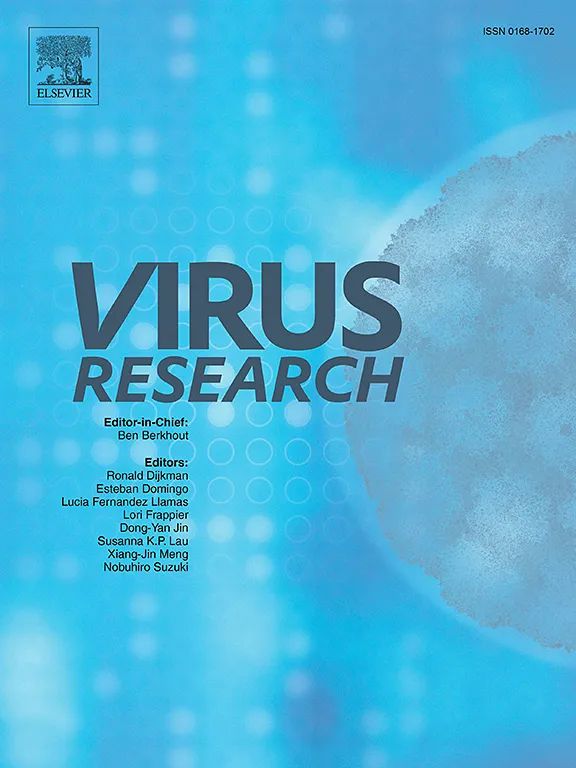Mosquito-borne alphaviruses in Zambia: Isolation and characterization of Eilat and Sindbis viruses
IF 2.7
4区 医学
Q3 VIROLOGY
引用次数: 0
Abstract
Alphaviruses in the family Togaviridae include zoonotic arthropod-borne viruses, including Sindbis virus (SINV), chikungunya virus, as well as insect-specific viruses such as Eilat virus (EILV). Previous investigations of alphaviruses in Zambia have identified a novel insect-specific alphavirus, Mwinilunga alphavirus in mosquitoes. Further ongoing surveillance resulted in the isolation of EILV and SINV for the first time in Zambia. Here, these alphaviruses were characterized in terms of growth kinetics in cells, and molecular phylogenetic relatedness to other alphaviruses. Zambian EILV (strain zmq19_M44) exhibited a close phylogenetic relationship with other insect-specific alphaviruses and shared a close nucleotide identity to those of EILV isolate (90.4 %) and Mwinilunga alphavirus (75.5 %). EILV zmq19_M44 attained a saturating titer in C6/36 cells at 6–8-days post infection but was unable to replicate in mammalian cells. Phylogenetic analysis revealed the Zambian SINV (strain zmq17_M115) belongs in Clade D of SINV Genotype 1 along with the Kenyan isolate BONI 584 from Central Africa. The growth of the SINV zmq17_M115 was comparable to that of the prototype SINV strain AR339 in mammalian cells but was statistically different in insect cells. Our findings will contribute to public health measures for the control of alphaviral diseases in Zambia.
赞比亚蚊媒甲病毒:埃拉特和辛德比斯病毒的分离和鉴定
托加病毒科的甲病毒包括人畜共患节肢动物传播的病毒,包括辛德比斯病毒(SINV)、基孔肯雅病毒以及埃拉特病毒(EILV)等昆虫特异性病毒。先前在赞比亚对甲病毒进行的调查已在蚊子中发现了一种新的昆虫特异性甲病毒Mwinilunga甲病毒。进一步的持续监测导致赞比亚首次分离出艾滋病毒和新冠病毒。在这里,这些甲病毒在细胞中的生长动力学以及与其他甲病毒的分子系统发育相关性方面被表征。赞比亚病毒株zmq19_M44与其他昆虫特异性甲病毒有密切的系统发育关系,与病毒株(90.4%)和Mwinilunga甲病毒(75.5%)核苷酸同源。感染后6 - 8天,EILV zmq19_M44在C6/36细胞中达到饱和滴度,但无法在哺乳动物细胞中复制。系统发育分析表明,赞比亚的SINV(菌株zmq17_M115)与肯尼亚的BONI 584一起属于SINV基因1型的D支系。SINV zmq17_M115在哺乳动物细胞中的生长与原型SINV菌株AR339相当,但在昆虫细胞中的生长差异有统计学意义。我们的发现将有助于赞比亚控制甲型病毒性疾病的公共卫生措施。
本文章由计算机程序翻译,如有差异,请以英文原文为准。
求助全文
约1分钟内获得全文
求助全文
来源期刊

Virus research
医学-病毒学
CiteScore
9.50
自引率
2.00%
发文量
239
审稿时长
43 days
期刊介绍:
Virus Research provides a means of fast publication for original papers on fundamental research in virology. Contributions on new developments concerning virus structure, replication, pathogenesis and evolution are encouraged. These include reports describing virus morphology, the function and antigenic analysis of virus structural components, virus genome structure and expression, analysis on virus replication processes, virus evolution in connection with antiviral interventions, effects of viruses on their host cells, particularly on the immune system, and the pathogenesis of virus infections, including oncogene activation and transduction.
 求助内容:
求助内容: 应助结果提醒方式:
应助结果提醒方式:


